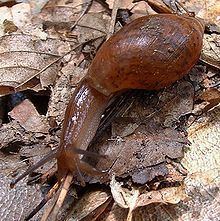Scientific name Euglandina | Superfamily Testacelloidea Subfamily Euglandininae Rank Genus | |
 | ||
Lower classifications Euglandina rosea, Euglandina singleyana | ||
Euglandina rosea f russac 1821 rosy wolfsnail mating
Euglandina is a genus of predatory medium- to large-sized air-breathing land snails, terrestrial pulmonate gastropod mollusks in the family Spiraxidae.
Contents
- Euglandina rosea f russac 1821 rosy wolfsnail mating
- Euglandina rosea f russac 1821 rosy wolfsnail
- Distribution
- Species
- Description
- Habitat
- References
These snails were previously placed in the family Oleacinidae (according to the taxonomy of the Gastropoda by Bouchet & Rocroi, 2005).
Euglandina is the type genus of the subfamily Euglandininae. The pulmonate genus Euglandina is often referred to as Glandina in older literature, and the most widely known species, Euglandina rosea, may commonly be found under the synonym Glandina truncata.
These snails are especially notable for being carnivorous and predatory. They are sometimes called "wolf snails" for that reason.
Euglandina rosea f russac 1821 rosy wolfsnail
Distribution
The natural range of Euglandina encompasses much of the tropical and subtropical Western Hemisphere, including the SE United States to Texas, Mexico, and various locations in Central and South America. The species Euglandina rosea has been intentionally introduced into many other warm areas — from Hawaii to New Guinea, Bermuda, Sri Lanka, Mauritius, and numerous other locations — in a vain attempt to control accidentally introduced species of snails, usually the giant African Achatina fulica.
Those species of Euglandina that are non-indigenous to the USA have not yet become established in the USA, but they are considered to represent a potentially serious threat as a pest, an invasive species which could negatively affect agriculture, natural ecosystems, human health or commerce. Therefore it has been suggested that these species be given top national quarantine significance in the USA.
Species
There are three subgenera and species in the genus Euglandina include:
Subgenus Euglandina Crosse & Fischer, 1870
Subgenus Singleya H. B. Baker, 1941
Subgenus Cosmomenus H. B. Baker, 1941
Subgenus ?
Description
The various species of Euglandina are similar in numerous ways. The shells are simple, oval in outline (sometimes broadly so) but occasionally more-or-less straight-sided, The lip of the aperture is also simple, without any thickening. These shells may be brown, orange, or pink in color, or some intermediate shade. Shell sculpture when present usually consists of striae that mark progressive growth increments. All species are carnivores, and probably have essentially the same hunting and feeding strategies, and reproductive techniques.
Habitat
Members of this genus can be found in many micro-habitats. Species of Euglandia can be found in semi-tropical moist jungle, and in near-desert. Their only requirements seem to be a relatively warm climate, and the presence of a sufficient supply of food organisms.
